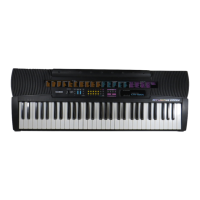3. Use the 0-9 buttons to input the 2-digit number that identifiesthe tone you want to select.
__ • Alwasy enter two digits for the tone number. If you. enter only one
_ _ _ digit, the display will automatically return to the previous tone number
. . setting after a few seconds.
• If you change the tone setting while a keyboard key is depressed, the
tone does not change until you release the key and press a keyboard
key again.
• With certain tones (such as percussion sounds and sound effects), there
may be very little or no change at all in the pitch, no matter which
keyboard key you press.
• You can specify tone numbers in the range of 00 to 99.
'_ * If you input the wrong first digit for a tone number, you can return to
the previous setting by pressing the TONE button.
Keyboard split tones
Some of the preset tones split the keyboard and assign two or more sounds. With
such a preset tone, the sound produced depends on what position of the keyboard
you play. For example, BASS/PIANO (tone 90) puts BASS on the left and PIANO on
the right of the keyboard.
<Example>
BASS/PIANO (No.90)
--BASS +" P,ANO
PERCUSSION (No.99)
• PERCUSSION (tone 99) assigns 35 percussion sound to the keyboard as illustrated
below. The sound assigned to each key are indicated above the keyboard.
E-18
_) BASS DRUM _ HIGH-MID TOM _ HIGH BONGO
SIDE STICK _ CRASH CYMBAL ! _ LOW BONGO
ACOUSTIC SNARE _ HIGH TOM _ MUTE HIGH CONGA
HAND CLAP _= RIDE CYMBAL 1 _ OPEN HIGH CONGA
ELECTRIC SNARE ,_g CHINESE CYMBAL _ LOW CONGA
LOW FLOOR TOM ",_' RIDE BELL _;_ HIGH TIMBALE
CLOSED HI-HAT _ TAMBOURINE _ LOW TIMBALE
HIGH FLOOR TOM zp SPLASH CYMBAL '_ HIGH AGOGO
PEDAL HI-HAT _ COWBELL _ LOW AGOGO
LOW TOM 'W" CRASH CYMBAL 2 Jf_ CABASA
_' OPEN HI-HAT _ CLAVES aO MARACAS
LOW-MID TOM _ RIDE CYMBAL 2
• There are no sounds assigned to any keyboard keys from B4onward when the "99
PERCUSSION" tone is selected.
Digital Sampling
A number of the tones that are available with this keyboard have been recorded and
processed using a technique called digital sampling. To ensure a high level of tonal
quality, samples are taken in the low, mid, and high ranges and then combined to
provide you with sounds that are amazingly dose to the originals. You may notice
very slight differences in volume or sound quality for some tones when you play
them at different positions on the keyboard. This is an una;coidable result of multiple
sampling, and it is not a sign of malfunction.
Polyphony
The term polyphony refers to the maximum number of notes you can play at the same
time. The CTK-520L has 12-note polyphony, which includes the notes you play as well
as the rhythms and auto-accompaniment patterns that are played by the keyboard. This
means that when a rhythm or auto-accompaniment pattern is being played by the
keyboard, the number of notes (polyphony) available for keyboard play is reduced. Also
note that some of the tones offer only 6-note polyphony.
• When rhythm or auto accompaniment is playing, the number of sounds simulta-
neously played is reduced.
• Other Useful Functions
To change the key of the keyboard
The transpose feature of this keyboard lets you raise or lower its key in semitone
increments. This means you can easily match to suit someone's voice, and you can
eliminate sharps and flats from music making it easier to play.
1. While in any mode besides the Song Bank Mode (indicated by a dot in the first digit of the
display),holddown the TONEbuttonand pressthe RHYTHMbutton.
_o_ * Perform step 2 within five seconds after performing n ]
step 1.
U
1
©
2. Use the TRANSPOSE/TUNE buttons to change the key of the keyboard.
'_ • Example: To change the tuning to B (indicated by-1 , ]
since it is one tone below C, which is the normal -
i
I
tuning of the keyboard).
• See page E-20 for the indicator that appears for each re-
Indicator
T.,.=o_u_ mains on the
key. display for a few
seconds.
Normal tuning B (-1) tuning
E-19

